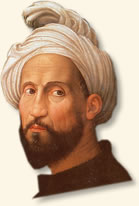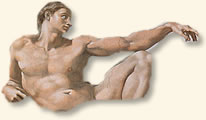|
Michelangelo Paints the
Sistine Chapel
Born in 1475, Michelangelo's artistic talent revealed itself early in his life, often to his family's dismay. His precocious drawings would occasionally elicit beatings from his father who wished to persuade the youth to follow a more honorable and lucrative profession than that of an artist. Fortunately, Michelangelo's stubborn refusal to abandon his talent persuaded his father to apprentice him to a Florentine artist at age fourteen. Mankind was awarded a creative talent whose genius was recognized not only in his own time, but in the generations to follow.
Michelangelo's first love was sculpture. Among his early works, the Pieta commissioned by the Vatican and David commissioned by the city of Florence proclaimed his unprecedented ability to transform marble from a slab of stone to a brilliant evocation of
 |
Michelangelo
from a contemporary
portrait |
the human experience. By 1508 the artistic community of Rome (including the painter Raphael and Donato Bramante, architect of St. Peters) felt so threatened by Michelangelo's mercurial rise to fame that they devised a plot intended to discredit and degrade the young artist. They would persuade Pope Julius II to have Michelangelo paint the ceiling of the Vatican's Sistine Chapel. They were convinced that the young sculptor, who had never attempted a fresco before, would inevitably fail or, at the very least, become embroiled in a time consuming effort that would remove him from the competition for years.
Michelangelo at first refused, protesting that he was a sculptor, not a painter. However, Pope Julius insisted and finally prevailed. It was arduous work that required the artist to constantly paint while lying on his back atop a scaffold that raised him to within inches of the ceiling. However, Michelangelo not only overcame these obstacles, but after four years, revealed a masterpiece.
Ascanio Condivi was one of Michelangelo's students. He was not a particularly successful artist, but he did have an intimacy with his tutor that allowed him to write a compelling biography that was published in 1553. He describes Michelangelo's experience during the four-year ordeal:
"While he was painting, Pope Julius often wanted to go and inspect the work; he would climb up by a ladder and Michelangelo would hold out a hand to him to help him up onto the scaffolding. And, being one who was by nature impetuous and impatient of waiting, as soon as the work was half done, that is from the door to midway on the vault, he wanted Michelangelo to uncover it while it was still incomplete and had not received the last touches. The opinion and the expectation which everyone had of Michelangelo brought all of Rome to see this thing, and the pope also went there before the dust raised by the dismantling of the scaffold had settled.
After this work, when Raphael had seen the new and wonderful manner of painting, as he had a remarkable gift for imitation, he sought through Bramante to paint the rest himself. This greatly disturbed Michelangelo, and before Pope Julius he gravely protested the wrong which Bramante was doing him; and in Bramante's presence he complained to the pope, unfolding to him all the persecutions he had received from Bramante; and next he exposed many of his deficiencies, and mainly that, in demolishing the old St. Peter's, Bramante was pulling down those marvelous columns which were in that temple, with no regard or concern for their being broken to pieces, when he could lower them gently and preserve them intact; and he explained that it was easy to put one brick on top of another, but that to make such a column was extremely difficult, and many other things which need not be told, so that, when the pope had heard of these derelictions, he wanted Michelangelo to continue, conferring upon him more favors than ever.
He finished this entire work in twenty months, without any help whatever, not even someone to grind his colors for him. It is true that I have heard him say that it is not finished as he would have wanted, as he was hampered by the urgency of the pope, who asked him one day when he would finish that chapel, and when Michelangelo answered, 'When I can,' the pope, enraged, retorted, 'You want me to have you thrown off the scaffolding.' Hearing this, Michelangelo said to himself, 'You shall not have me thrown off,' and he removed himself and had the scaffolding taken down, and on All Saints' Day he revealed the work, which the pope, who went to the chapel that day, saw with immense satisfaction, and all Rome admired it and crowded to see it.
 |
Creation of Adam
from the Sistine Chapel |
What was lacking was the retouching of the work a secco with ultramarine and in a few places with gold, to give it a richer appearance. Julius, when the heat of his enthusiasm had subsided, really wanted Michelangelo to furnish these touches; but, when Michelangelo thought about the trouble it would give him to reassemble the scaffolding, he answered that what was lacking was nothing of importance. 'It really ought to be retouched with gold,' answered the pope, to whom Michelangelo responded with the familiarity which was his way with His Holiness, 'I do not see that men wear gold.' The pope said, 'It will look poor' Michelangelo rejoined, 'Those who are depicted there, they were poor too.' So he remarked in jest, and so the work has remained.
For this work and for all his expenses, Michelangelo received three thousand ducats, of which he was obliged to spend about twenty or twenty-five on colors, according to what I have heard him say. After he had accomplished this work, because he had spent such a long time painting with his eyes looking up at the vault, Michelangelo then could not see much when he looked down; so that, if he had to read a letter or other detailed things, he had to hold them with his arms up over his head. Nonetheless, after a while, he gradually grew accustomed to reading again with his eyes looking down. From this we may conceive how great were the attention and diligence with which he did this work."
References:
Condivi's account appears in: Condivi, Ascanio, The Life of Michelangelo, translated by Alice Wohl (1976); Boorstin, Daniel, The Creators (1992); Janson, W.H., History of Art (1977).
How To Cite This Article:
"Michelangelo Paints the Sistine Chapel," EyeWitness to History, www.eyewitnesstohistory.com (2005).
|






